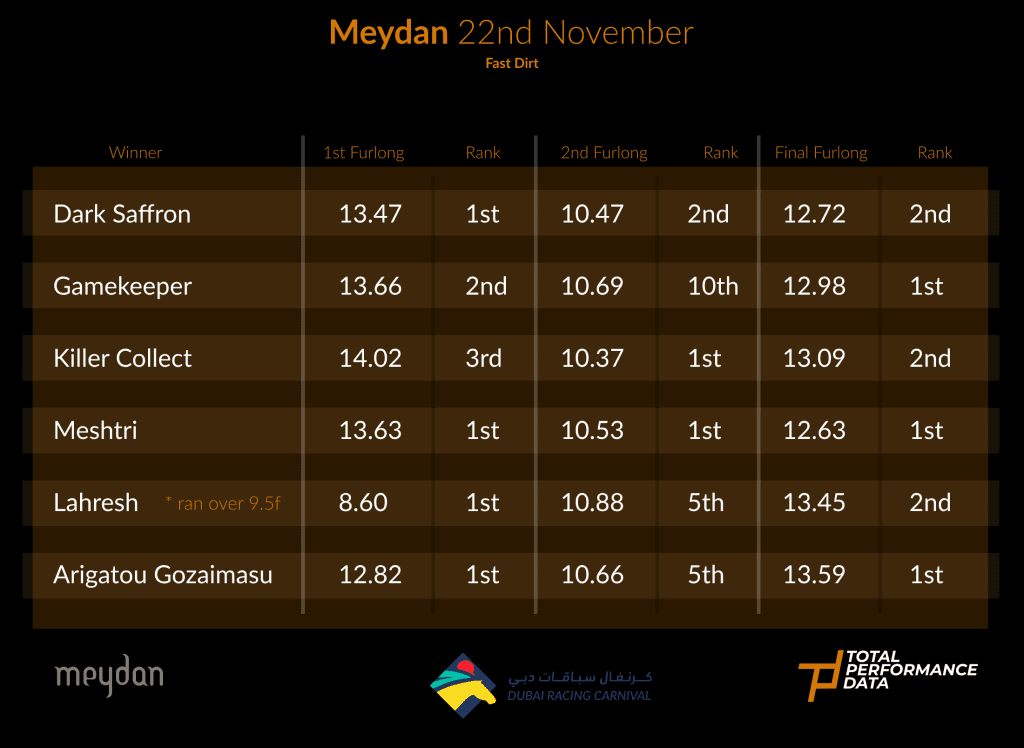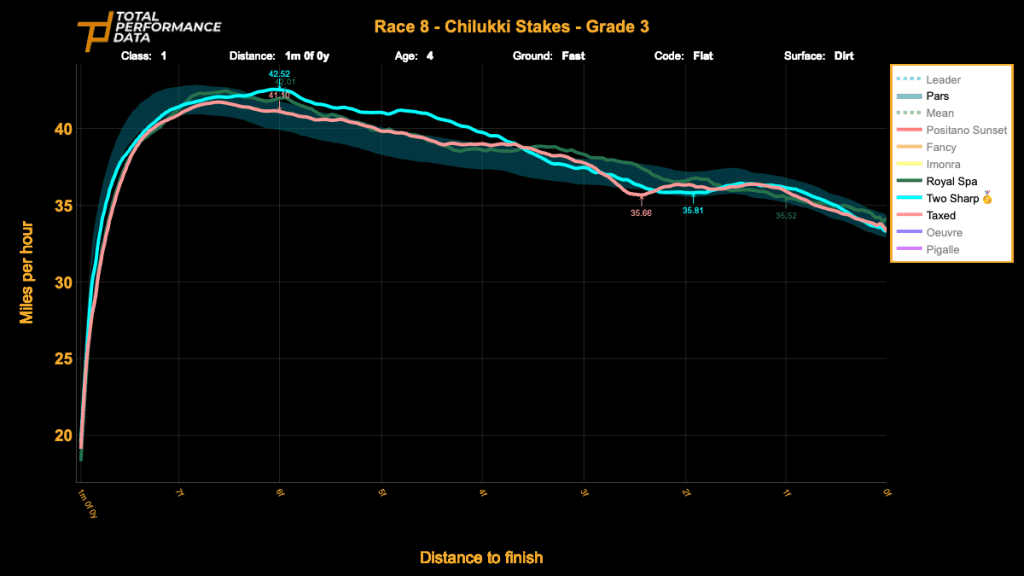A weekend of contrasting conditions is perhaps the best way to describe this weekend’s review. On the one hand we have the fast dirt conditions in Dubai that continue to favour early speed and on the other hand, we have the deep mud at Haydock where the first Grade 1 race of the British Jumps season turned into a war of attrition. Here are a few eye-catching performances from the TPD data from around the world this weekend.
Meydan
Dubai Creek Mile sponsored by Nakheel (Listed)
Meshtri shines as the track bias continues. It’s taken a long time for him to deliver on the earlier promise that he showed, but Meshtri’s connections have been rewarded for their patience with a Listed win in the Dubai Creek Mile. Unlike 2-weeks ago, he broke well on this occasion, reaching the furlong pole in 13.68s. In fact, he ranks first for both the opening furlongs (13.68, 10.53s) and the final furlong (12.63s) as well as clocking the fastest top speed figure (43.58 mph) and the best run-out speed (33.76 mph) in the field too. There was no fluke about this victory despite the 12/1 SP in the International markets and whilst a case could be made that the runner-up threw the race away in the closing stages when seemingly refusing to go past, I would argue that’s an unfair assessment on Meshtri. He has run the fastest final furlong in the field and he has increased his average stride length from 7.02m in the penultimate furlong to 7.07m in the last. It’s a small increase, but this figure, coupled with his top run-out speed suggests that there was more in the tank had he needed it.


In a wider point, I could fill this column with horses that were unlucky on Friday night. The track bias on the dirt, which has heavily favoured front-runners so far this season continued. The winners of the 6 thoroughbred races all raced prominently and when we ranked them based on the time it took them to reach the first furlong pole, they were 1st, 2nd, 3rd, 1st, 1st and 1st. To be fair to the winners, they have all ranked either 1st or 2nd for the final furlong too, but the amount of energy needed to get on terms, especially against a relatively fierce kickback from the dirt, made it very hard work for any horse that wasn’t in the front rank after the first 300-metres or so. I won’t list all of those who were given too much to do after slower starts, but Go Soldier Go does stand out. He was slowly into stride in the Thunder Snow Handicap and having been 2.02s slower over the first 2 furlongs than the eventual winner Lahresh, he finished well to be beaten 6 lengths, running the fastest final furlong in 13.23s. He hasn’t won since landing a pair of carnival races in 2023, but this was a pleasing return after a 9-month absence and if he can break on better terms next time, he will be of obvious interest.
Churchill Downs
Chilukki Stakes (Grade 3)


Two Sharp is too sharp as he dominates the Chilukki Stakes. Trained by Philip Bauer, this son of Twirling Candy is now 3-5 in his short career and he took this first step up to the mile trip with ease to land a comfortable success. His pace map shown above tells the story of a rapidly improving horse who was fastest over each of the first 4 furlongs, as well as the 7th and who had readily burned off his rivals by the halfway stage. As much as 6-lengths clear turning in, Junior Alvarado barely moved a muscle as his mount cantered home in a winning time of 1:34.40s. Both Royal Spa (2nd) and Taxed (3rd) had form at the track but they were simply unable to lie up with the strong early pace of the winner, who now looks destined for bigger targets in 2025.
Haydock
Betfair Chase (Grade 1)


Royale Pagaille wins a war of attrition in the Haydock mud. Visually this may not have been the greatest race to watch, but this was a remarkable front running performance from Royale Pagaille, who won in his ideal conditions. A winning time of 07:07.20 is the slowest winning time for this race in the last 10 years and despite the Grade 1 performers on display, a top speed figure of 30.60 mph from the winner shows the effect the ground had on this race. Even when compared to the other Chase winners on the card, that figure seems low. The handicap chase winners Dr T J Eckleburg (32.73 mph) and Fontaine Collonges (31.09 mph) were able to produce quicker speeds during their races despite being rated more than 20 lbs or more below this field. Royale Pagaille ran over the longer trip and that needs to be accounted for, but in such attritional conditions this race looks likely to leave a mark. If we compare the run-out speeds of Royale Pagaille and Grey Dawning, taken 2-seconds after they had crossed the line, it suggests that both of them were running on fumes and are likely to take some considerable time to get over these exertions.
Ascot
Celtic Dino jumps his rivals into submission. He wasn’t the fastest horse on the day, nor did he sprint clear of his 5 rivals in this Introductory hurdle on Friday. Instead, Celtic Dino produced the most efficient round of hurdling across the 2 day card at Ascot and that won him this £15k prize. The Jumps Data provided by TPD confirms that he lost an average of just 3.2% of his speed over his obstacles and even as he tired in the closing stages, he was still losing as little as 5.2% speed. For comparison, the 2 horses that chased him home, Wade Out and Joyeuse have
figures of 9.2% and 5.8% at the end of their races. This was a remarkable display from such an inexperienced horse and he compares well with the older and more battle hardened rivals who ran at Ascot this weekend too. The former Betfair Hurdle winner Aucunrisque lost an average of 4.9% at his hurdles on his way to winning the handicap hurdle on Friday’s card, whilst Saturday’s Ascot Hurdle winner Lucky Place lost 6.7% on average at his obstacles. Sam Thomas’ 5-year-old has now won 4 of his 5 starts and it will be fascinating to see what the handicapper does with his opening mark this week, but with such good efficiency over his obstacles, he is likely to remain competitive as he rises through the grades.